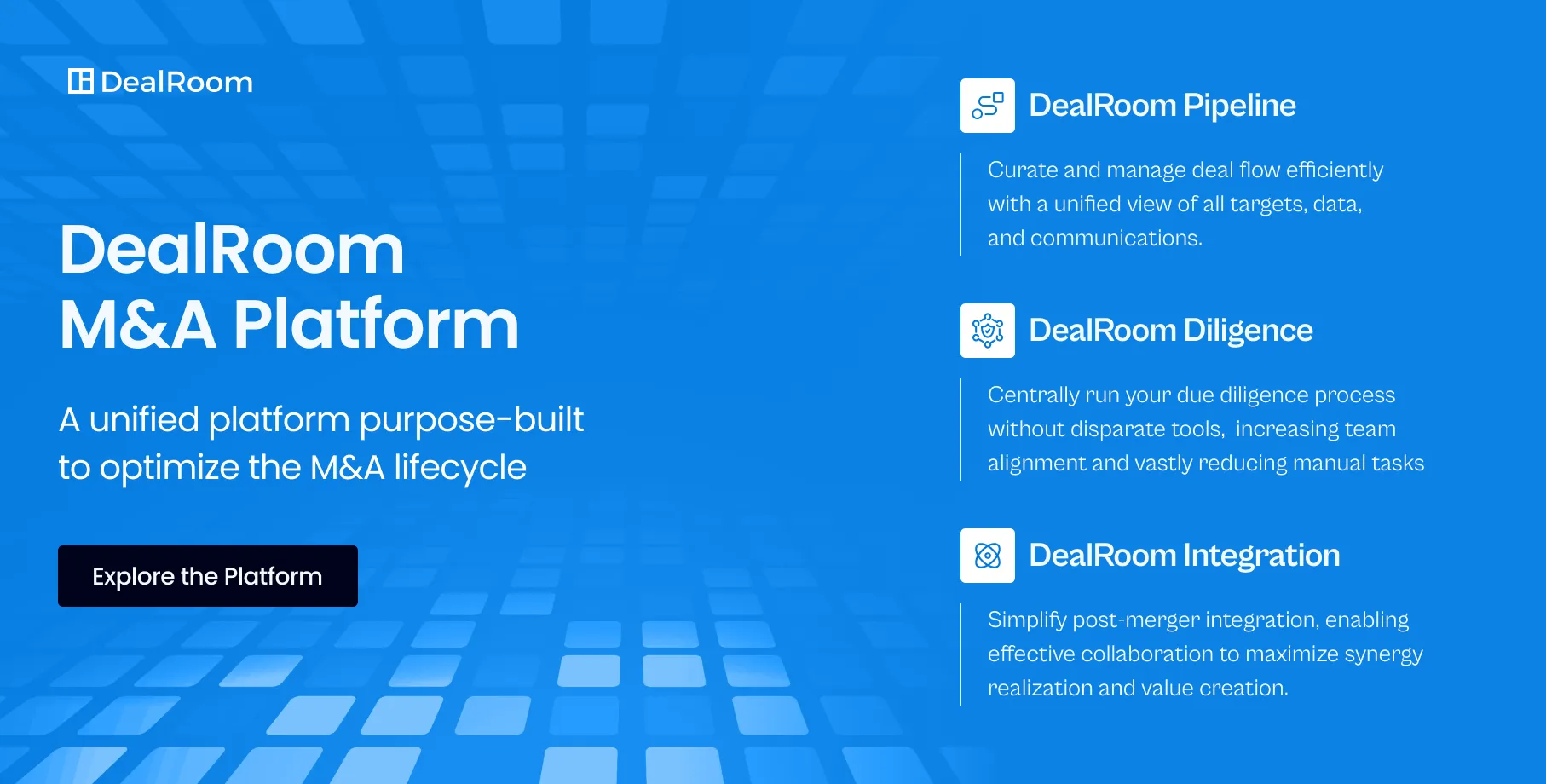So, what is acquisition M&A financing?
M&A Financing is the process through which companies fund their mergers and acquisitions.
Most M&A transactions involve considerable amounts of capital, sometimes obligating the buyer to finance a deal through financial resources other than the company’s own cash reserves.
Understanding which method to fund a deal goes to the core of good M&A financing.
The right business acquisition finance depends on your business, the business being acquired, and where both are in their cycle.
We, at DealRoom, help many companies organizing their M&A process and below, we outline ways in which you can finance a business acquisition.
How are most acquisitions financed?
Acquisitions are mostly funded from a combination of debt and equity. If the company doesn’t have its own funds available for an acquisition, it can avail of the required capital through third party debt (bank loan, SBA loan, private debt, etc.), owners’ equity, or even a line of credit.
Same as individuals go through credit-building process using credit builder loan online, companies go though due diligence process to get financing.
The decision on which method to use will depend to a large extent on the buyer’s financial position, the prevailing interest rate, and the target company’s willing to accept equity as part of the deal.
Debt vs equity M&A financing explained
As we've said most M&A transactions use a combination of debt and equity financing.
Debt M&A financing involves using third party debt to pay some or all of the cash required to close the deal. These funds can come from outside investors (private equity or private debt) or more traditional financial institutions (banks, credit companies, etc.).
Equity M&A financing is funding the deal with the buying company’s own equity.
The different implications for each of debt and equity financing are summarized in the table below:

How does acquisition financing work?
Smaller companies can reap multiple benefits from acquiring other companies, such as business synergies and economies of scale.
In order to acquire another company, the buy-side must review different business acquisition financing options (10 are described and analyzed below).
Let's start with an overview of all the m&a financing options and how to fund an acquisition.
How to finance a business acquisition
- Company Funds
- Company Equity
- Earnout
- Leveraged Buyout
- Bank Loan
- SBA Loan
- Asset-Backed Loan
- Issuing Bonds
- Third-Party Financing
- Joint Venture
1. Company Funds
Let's start with the first acquisition financing method. As mentioned at the outset, if your company is fortunate enough to hold plenty of cash, it may be possible to acquire business by means of a transaction which is 100% cash financed.
However, although the vast majority of acquisitions involve some upfront cash payment, it’s remarkably rare to finance the entire deal in this manner.
With so many other financing options available - many of them lower risk than bringing down your own company’s liquidity - it’s best only to consider some form of hybrid deal that works for both parties.
It’s also highly likely you’ll need some of that cash balance during the post-merger integration of the newly acquired business.
2. Company Equity
Offering equity to the owners of a target firm can be an excellent way of smoothing the process, particularly where they’re interested in maintaining some control.
Assuming both firms merge into a new entity, this would involve giving them some equity in the newly merged firm. (With the equity share offered to them being based on a valuation of the new firm by an objective third-party).
Alternatively, it could be that both firms remain separate entities under a holding company, and the equity share is based on a valuation of the target firm.
In both cases, the benefit to you is paying less cash and retaining some of the seller’s expertise and insight, thus making company equity a powerful acquisition funding option.

3. Earnout
An earnout is one of the most creative ways to finance an acquisition. This works best where the seller is already considering an exit and is relatively flexible on payment terms.
The benefit of an earnout to a seller is that most (or in some cases, all) of the transaction fees that you pay are contingent on the firm’s ongoing success.
So, to take a basic example, you could pay 30% of the firm’s value upfront and 20% of its revenues in each of the first five years after the acquisition. You can see how this could become creative quite quickly, involving all manner of triggers and clauses.
But in cases where, say, an owner is looking to retire while his or her business still has plenty of roads to run, an earnout allows them to benefit from the medium-term revenues in the short term.
And still, leave the business and enjoy retirement in the short term.
4. Leveraged Buyout
Leveraged Buyouts (“LBOs”) gained notoriety in the 1980s as major corporate leveraged buyouts gained popularity, but they’re not restricted to blue-chip companies.
Leveraged buyouts are similar to earnouts in the sense that they allow the buyer to commit very little of their own capital. Instead, you use leverage (debt) on the assets of the business being purchased.
Of course, this demands that you’re able to generate enough cash flow to cover the debt service from the cash flow generated by the acquisition.
If this sounds like a high-risk, high-reward strategy, it is. An LBO has a huge payoff if you manage to pull it off, but it can quickly sink those businesses that don’t.
But, let's review business acquisition funding through acquisition loans.
What is a business acquisition loan?
A business acquisition loan is a loan given to a company for the specific purpose of acquiring another company or asset; it is a common way of financing an acquisition. There are often restrictions that accompany these loans, such as time limits. The lender also determines the amount of the loan and who is eligible for the loan.
Read our article on largest and most recent leveraged buyout examples.
5. Bank Loan
This method of business acquisition financing doesn’t require much explaining.
Most banks, even those dealing with SMEs, have specific provisions put aside for business acquisitions. With interest rates remaining historically low, 2021 should still be a good time to avail of this option.
Generally, acquisition loans use the acquired assets as collateral to secure the loan. It works similar to secured personal loans where you have to provide an asset to guarantee the loan, such as a vehicle, savings account, or certificate of deposit.
Although it’s never a bad idea to shop around when looking at debt options.
Your own bank will often provide the best terms: aware that the future prospects of your business are looking positive, they’ll be keen to keep your business in house.
It goes without saying that this is an angle that you should leverage when looking for a bank loan for a business acquisition.
6. SBA Loan
SBA loans will cover 75% of the value of acquisition between $150,000 and $5 million.
There’s a long checklist of items that you’ll need to deal with before obtaining an SBA loan, but it’s one of the most straightforward methods of financing available.
The interest rate available is also competitive, currently coming in at around 8 to 10% for loans of over $50,000.
The repayment can be made over a period of seven to ten years. It means a well-planned acquisition should safely cover the loan interest expenses, allowing your business to benefit from the extra cash flow in the short-term.
7. Asset-Backed Loan
An asset-backed loan is similar to a leveraged buyout in that you’re essentially using the value generated by the target company to acquire it.
However, unlike a leveraged buyout, where the financing is generally provided on the basis that you can show that the acquisition will generate cash flow, an asset-backed loan is made on the basis that the assets of the target firm can be liquidated in the worst-case scenario.
You’re gaining financing on the value of the target’s assets (but not their liabilities).
As with an LBO, this is one of the riskier strategies for financing a business acquisition, and it may be difficult to find someone willing to finance the assets at a price that meets the seller’s valuation of their own business.
8. Issuing Bonds
Issuing bonds is an excellent way to fund the acquisition of a business. Although a bond issue is technically more complicated than an SBA or bank loan, this method forces you to think about how you’ll pay off the debt in installments over a given period.
This strategy will be set out in your private placement memorandum before being distributed to relevant investors.
There’s a considerable amount of technicality involved here, which varies from state to state, but you will need to keep a serial number for each bond sold and to make payments at regular agreed intervals.
You can set the coupon rate of the bond, but you should be realistic - are people going to want to fund your acquisition at a coupon rate of 5% when they can acquire the corporate debt of a blue-chip company at a similar rate?
9. Third-Party Financing
There’s a growing number of non-traditional finance firms out there that can assist in all manner of business operations, including acquisitions.
Typically, these are private equity firms and their provision of funds will involve them acquiring some of the equity of the newly formed firm on the understanding that they can become involved in some of the management decisions.
This is not a bad way to go, potentially allowing you to tap into a new network of experienced industry professionals that can generate significant value through your acquisition.
10. Joint Venture
Although technically not a method of financing, entering an acquisition through a joint venture (JV) with another firm can be an excellent way to gain (joint) control of a business, with a lower upfront cost.
There are several caveats, however. It can be challenging to find a suitable JV partner, as many joint ventures destroy value as creating it, and your efforts to make management decisions at the acquired business may be stifled in the long run by virtue of controlling less of its equity.
Nevertheless, where two businesses can find the right harmony, the combined expertise provided by two sets of management can generate considerably more value.
Conclusion
Clearly, acquisition funding can take many shapes and forms depending upon your company’s financial situation and goals.
Although there are many financing options, the financing strategy for the acquisition is very specific to the deal.
It should also be noted, acquisition financing must take into account what it will cost to run the business after the deal is done.
Read also
Cash-Free Debt-Free Acquisition (M&A) in Simple Words




















.png)
.webp)



.webp)
.webp)
.webp)





.png)
.png)
.png)
.svg)

.svg)
.png)
